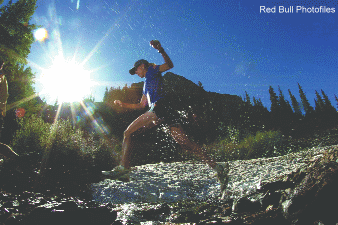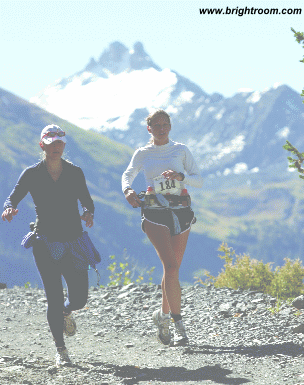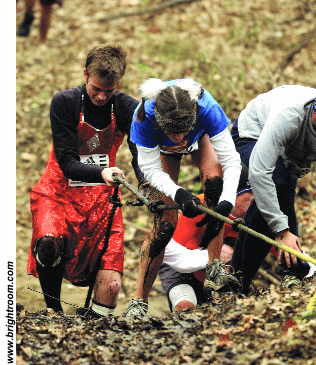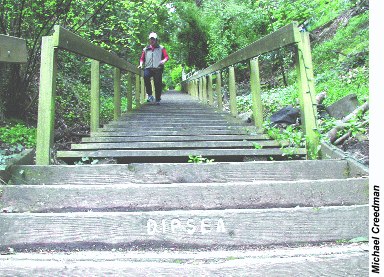|
||||
|
Articles
| Shoes
| Travel Guide | Camps
| Marathons
|†High School
|†Training
| Links
|†Bookstore
| Women's
Section | Injury
Guide
|
||||
| † |
|
|||
| † |
Short and Sweet (and
Muddy, and Steep)
|
† | ||
| † |
In this story, we highlight six great American sub-marathon trail running races: the 17.8-mile Shut-In Trail Race in the mountains near Asheville, NC; the Virgil Forest Frolic trail runs (7K and 15K), part of the quirky Finger Lakes trail series in upstate New York; the 10K Living History Farms cross country style race near Des Moines, IA; the lung-burning, 17.1-mile Imogene Pass Run in the thin air of the San Juan Mountains of southwestern Colorado; the 100-year-old Dipsea trail race, a hilly, 7.1-mile point-to-point race that sends runners racing to a beach north of San Francisco; and the revamped, 16.5-mile Gold Discovery Run, which celebrates the gold-mining heritage near Fairbanks, AK. If space permitted, dozens of other trail runs could have made the final cut. In fact, dozens of others were considered. But these six races are emblematic of what trail running is all about: a chance for runners to challenge themselves amid the raw terrain and natural features on the unique environments in which they are set. Some are run on dirt roads in the country, some are run on singletrack trails in the mountains, and others still are run on the rolling hills of farm fields. None of the races are flat; most have steep climbs, fast descents, rough footing, creek crossings, and other unique natural features such as wildflowers, lush green forests, roaring rivers, and even snow-capped peaks. And when it comes to weather, sun, sleet, snow, rain, fog and humidity are just a few of the things you're bound to encounter on the trails. Given the undulating terrain of the arduous courses and crazy weather, don't expect to run a consistent pace in any of these races. But if you're looking for a PR, you might be missing the point. Trail running is about getting away from the crowds, the pavement, and the congestion of urban America. Running in natural conditions provides a return to primal urges. Like animals chasing predators on a game trail or through an open field, your competitiveness and drive as a runner take on an entirely new meaning when you venture off-road. In most cases, it also offers the chance to experience first-hand the history woven into the fabric of the race. Whether you are new to running or a veteran road marathoner, a short-distance specialist or an experienced ultrarunner, these trail runs are sure to challenge you to your core. 4Brian Metzler
FOREST FROLIC 7K & 15K You9ve probably heard it before, or seen it on a T-shirt: "Ithaca Is Gorges." It is. But the small town in upstate New York is also a trail runner9s mecca; it9s a place filled with rolling hills and green pastures and fit and interesting people. If you9re in Ithaca and want a good run, you need only go up (up, up) to Cornell9s campus at 12 p.m. on any weekday to join the folks of the High Noon Athletic Club. The area is also home to the Finger Lakes Runners Club, a group of trail hounds with a knack for hosting great races. Twenty years ago ultrarunner Joe Dabes launched the first trail run in the area, the 21.1-mile Virgil Mountain Madness, patterned after the neighboring Catskills9 Escarpment Run. Now there9s a series of 10 trail races that range in distance from the good-for-beginners Tortoise and Hare 10+K to the Finger Lakes 50s, where runners have the choice of going 25K, 50K or 50 miles. "We pride ourselves in putting on races that accommodate the average runner as well as the competitive runner," says club president Lorri Tily. Many of the races have options of various4and sometimes unusual4distances. There9s the Tom Bugliosi 13K and 26K; the Virgil Mt. Madness 12K and 30K, the Forge the Gorgeous 7 Miler, as well as the more traditional distances offered by the Monster Marathon and Half Marathon. Perhaps the most inviting of the trail runs is the Virgil Forest Frolic4with 7K and 15K races. Again, giving folks maximum flexibility and choice, the 15K allows runners to choose which direction they want to go for the first loop: you can either start climbing, or finish by tearing down a difficult, rocky hill. "Despite taking pains to mark the course well," says race director Steve Ryan, "some directionally challenged runners often get off course." Not unusual in a trail race. However, the friendly people of the Virgil Forest Frolic have done what they can to help: The much-coveted "Trail Raptor" shirt has, according to Ryan, "the course map printed upside down on the front, so that if one is in need of directions you only have to look down." For an entry fee of $6, you get to line up with 130 or so other runners and then, after the race, share the "traditional" Archway cookies, soda, and beer and score your own Trail Raptor tee. 4Rachel Toor
SHUT-IN RIDGE 17.8M If you don9t mail in your race entry the minute you get it, you are likely to be shut out of Shut-In. People wait expectantly by their mailboxes every August, knowing that they will need to immediately turn around the modest Xeroxed form that will allow them to enter one of the most beloved trail races in the Southeast; the race fills in three days or less. In the quarter century of its existence, the Shut-In Ridge 17.8M Trail Run has built a reputation for being hard4and wonderful. It9s a brutal slog almost entirely up4gaining nearly 5,000 feet4the old road that millionaire George Vanderbilt made to get from his stately Biltmore estate in Asheville, NC, to the top of Mount Pisgah. The last couple of miles are so steep and technical that you often see runners hanging on to trees to keep from falling backward. At the pre-race dinner you hear the squeals and hearty laughs of reunion. Newcomers are treated to tales of the trail, and told that they should figure it will take them about as long as a road marathon to cover the 17.8 miles of trail. The Carolina Godiva Track Club, based in Durham, NC, sends a posse of runners each year. And each year, more join the pilgrimage, attracted by the descriptions of the natural beauty of the course and the tales of splashing in hotel hot tubs after the race. One of those brought into the fold was Karen Murphy, 26, of Durham. After last year9s race, Murphy9s comments were not atypical: "All the hills are one notch steeper and one notch longer than I would have liked, and there9s no way to adequately prepare for the last mile and a half. I was having conversations with God and would have sacrificed a goat if it meant that the top of that last hill would come into sight." Then she adds, "I loved it," and says she is looking forward to doing it again. You9d be hard-pressed to find a more enjoyable place to spend the first weekend in November. Asheville offers something for everyone: great restaurants, lots of culture, hemp-wearing hippies, followers of Billy Graham, and the lush scenery and moderate climate of the southeast, as well as plenty of quaint bed and breakfasts, and beds in cheaper chain motels. It9s a great destination race; running it is not nearly as hard as getting in. 4Rachel Toor
The Imogene Pass Run, although 17.1 miles long, produces times that tend to be very close to "flatlander" road marathons. How? Blame it on the profile of the point-to-point course, which looks like a triangle that starts in Ouray at 7,810 feet above sea level, ascends without mercy for 10 miles to the 13,120-foot Imogene Pass, and then drops down just as unforgivingly to Telluride, at 8,820 feet in altitude. The setting of the two mountain towns is steeped in Colorado9s mining history, with quaint Victorian homes and colorfully named streets and landmarks. The incredible mountain views, which are often accented by shades of gold, yellow, orange, and, if you9re lucky, red Aspen leaves, make the thin-aired grind a bit less taxing. The time of year can, however, translate into some capricious weather, especially when runners get above tree line. It is not uncommon for the field of racers to get snowed on at the Pass or for participants to turn back to Ouray due to an insufficient wardrobe. The race, first run in 1974 with a field of six, now attracts a competitive pool of more than 1,000 runners with the top performances coming from local mountain running specialists. The climb from Ouray to the Pass is steady, and the first third of the field is often able to run almost the whole way, given that the footing and steepness of the jeep road ascent is a consistent, if painful, grade. The descent is a bit more technical, with loose talus, oxygen deprivation, and general fatigue causing those unaccustomed to high mountain trail running to pause. Further down, the wide trail passes through a short but exciting tunnel, and the allure of Telluride is enough to revive tired spirits for the finish in one of Colorado9s most beautiful of mountain town settings. 4Adam Chase
When trail runners seek a race featuring tough terrain, adverse conditions, and a story for the scrapbooks, most people don't think of Iowa, but they should. Between the furrowed corn and bean fields, at 955 feet above sea level on the edge of Iowa's capital city, you'll find the largest cross country foot race in the United States. The farm race created by Fitness Sports and The Living History Farms in Des Moines plays host to nearly 4,000 harriers who are willing to traverse muddy trails, cross creeks, and climb over hills and bales. In its 26th year, this 10K course guarantees that when you finish you'll be wet, muddy, cold, and exhausted; if you're fast enough you may be among the few to bring home the turkey for Thanksgiving. At the start, an old Honda motorcycle leads the way through the opening miles down a dirt road, through a tunnel, and into the open field. At mile two the field ends and the woods begin with the next three miles of meandering trails, steep climbs (rope optional), and several waist-deep creek jumps' and if you're not jumping, you'll be wading! By mile five you may be out of the woods, but you're done like a good Iowa pork chop. To finish you off, the final mile enters a hilly cow pasture equipped with cow pies and steeple-style straw bales. Etched in memory is my first farm race back in the day when the gate was closed to the pasture, for good reason, the cows were in. As I hurdled over the gate, a very beefy Black Angus bull stood meters away chewing cud. I high-tailed it as best as I could, and I never looked back. In the 2004 race, a rainy week made conditions tougher than usual, with the creeks running on the high water mark, but that didn't slow the frontrunners. Defending champ Eric Graham of Kansas was leading the charge in the early miles, eyeing a repeat win, but it was Brad Lowery from Brookings, SD, who bested the course and the field in 34:40 to Graham's 34:51. In the women's race, returning champion Sarah Gall from Cedar Falls, IA, held off Sheena Dauer of Brookings, MN, running 40:27 to Dauer's 40:39. A top-20 finish was a goal of mine going into the race, but just being back on the farm for this Iowa boy now living in Boston made every painful minute pleasurable. Add a little rope burn, a cool T-shirt, the Cornish gamehen (a frozen one) for third in my age group, and I called it a good day's work. If running fast isn't your thing, then the costume competition may be your calling. The general dress code is "anything goes with mud," and skin is in. Despite the typical raw November weather, men with skirts, sans shirts, were popular, as were the cast of the Wizard of Oz, making the trip up from Kansas. Superman, Spider-Man and Madonna, just to name a few, braved the course and didn't mind the mud. If by chance a runner didn't get muddied enough on the run, there was plenty of mud slinging at the finish by friends. Not a bad way to end the cross country season, having a blast, drinking hot cider, telling stories, and cranking the heat all the way home. Michael McGrane
GOLD DISCOVERY RUN 16.5M It9s taken more than a century, but the route for the Gold Discovery Run near Fairbanks, AK, has come full circle. The course of the GDR, which will celebrate its 40th running this July, has evolved from raw wilderness, when prospector Felix Pedro traveled it 103 years ago, to pavement, when the pounding run was established in the mid-1960s, to mostly trails and dirt and gravel roads, when it was re-invented three years ago. When Pedro, a tireless Italian immigrant, discovered gold along a stream in 1902, he likely followed a path for more than 15 miles through the wilderness to spread the news in Fairbanks, which at the time had little more than a trading post on the Chena River. The population then swelled dramatically and within 16 months the town of Fairbanks was incorporated. By the time the Gold Discovery Run was founded in the mid-1960s, a monument commemorated the site at Pedro Creek. There the 17-mile race began, and the paved and mostly flat Old Steese Highway brought it to the finish line in a downtown Fairbanks park. That route, however, ran its course, and in 2002, the year Fairbanks celebrated the centennial of Pedro9s gold discovery, a new course was established. It eliminated much of the pavement and opted for a slower, but more forgiving and more scenic, route that begins at a spot in the hills above Pedro9s original gold strike and ends 16.5 miles later with a festive cookout on the grounds of the Silver Gulch Brewery in the historic mining community of Fox, 10 miles from Fairbanks. Reception of the new course has been universally positive, according to Mike Kramer, an avid trail runner who helped redesign the route and serves as one of the race9s directors. Participation leaped from 90 to 158 runners when the new course was instituted. The course change was brought about "mostly from complaints from runners about running on pavement, and declining participation," said Kramer, who won the inaugural new race in 1:33:54. Last year visiting Kenyan Moses Waweru broke that record with his 1:32.41. The all-time GDR record of 1:25.49, set by Bob Murphy in 1986, is likely out of reach given the rigors of the new course. Keeping the historic flavor of the race, run during Fairbanks9s annual Golden Days festival in late July, was vital, said Kramer. "We wanted to maintain the link with the gold mining in Fairbanks and the Fox valley," he said. Runners see the Fort Knox Gold Mine while being bused to the race9s start, then run along ridges with views of the Alaska Range (if there9s no smoke from wildfires), through spruce and birch forests, and on roads4some dirt, some paved. They travel along the old Fairbanks to Circle Mining Trail, the gravel Goldmine Trail, and cross the paved Goldstream Road. The course still exacts its share of punishment, however, with 1,648 feet of climbing and 3,198 feet of descending. Weary quads and calves can be soothed with free beer and burgers at the post-race ceremony. Not everyone was pleased with the race9s course change, however. Long-time former director Guy Williams would have preferred the GDR course continue unaltered, with the new course becoming a separate race. "It9s not really the Gold Discovery Run anymore. It9s totally different," said Williams, an Alaskan since 1953. "I probably would have kept it the same way. It was the course that Pedro took to Fairbanks to stake his claim." Pedro, however, could probably live with each course. After all, he got a second chance. After initially discovering gold in 1898 on "Lost Creek," he inexplicably lost the spot, never to find it again. And now history has repeated itself, as the Gold Discovery Run has again struck it rich on its second attempt, now as a trail race that is quickly becoming a classic. 4Matias Saari
The 7.1-mile Dipsea trail race combines a little bit of everything as it snakes its way from the town of Mill Valley, 10 miles north of San Francisco, to the idyllic seaside community of Stinson Beach. After a short stretch on pavement, runners must tackle 676 steps as part of a grueling 600-foot rise in the first mile. After a gradual downhill, runners must shift into second gear for an arduous, two-mile, 1,200-foot climb to the high point on the course. From there, it9s a series of wickedly steep, thigh-burning downhills to the finish line on the beach. This year marks the Centennial Celebration of the Dipsea, the oldest trail running race in the United States. It got started in 1905 when the Olympic Club, an athletic club dating back to the 1860s, decided to create an annual running race a year after two club members ran a match race along the Dipsea Trail from Mill Valley, through Muir Woods and down to the beach. Legend suggests that club members wagered wildly on the event and that runners Charles Boas and Al Coney could have been under the influence of "spirits" in the first unofficial Dipsea. Two elements remain from the original Dipsea. The course is essentially the same as it was 100 years ago, aside from the elimination of a few legal shortcuts. The race still uses incremental head starts for gender and age handicaps, something that allows Dipsea runners to age like fine wine. In 2004, 63-year-old Shirley Matson won the race for the fourth time, making the most out of a 22-minute handicap. She beat 66-year-old Russ Kiernan, who had a 15-minute handicap, by 29 seconds. Last year marked the first time since 1930 that Jack Kirk didn9t run the race, ending an amazing streak that covered 68 consecutive races. The venerable "Dipsea Demon," so named for the way he attacked the course in his youth, was on hand to watch from a wheelchair while recovering from a broken hip. Kirk is 98 this year and has repeatedly said he wants to continue running the race until he9s 100. Don9t bet against him. For some, the allure of the Dipsea is merely getting a chance to run in the race. It has a strict cap of 1,500 participants, with priority going to finishers from the previous year and nearby residents. 4Brian Metzler
|
† | ||
| † | (This article originally appeared in
the June 2005 Running Times) |
† | ||
|
Articles | Shoes | Travel Guide | Camps | Marathons | High School | Training | Links | Bookstore | Women's
Section | Injury Guide
|
|
|||

 Running races are like snowflakes:
No two are the same. But when it
comes to trail running races, very few are even similar.
Running races are like snowflakes:
No two are the same. But when it
comes to trail running races, very few are even similar. IMOGENE
PASS RUN 17.1M
IMOGENE
PASS RUN 17.1M LIVING
HISTORY FARMS RACE
LIVING
HISTORY FARMS RACE THE DIPSEA 7.1M
THE DIPSEA 7.1M